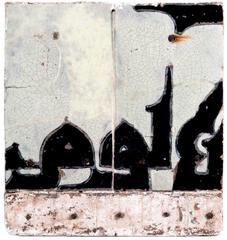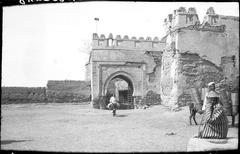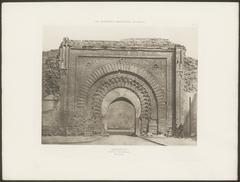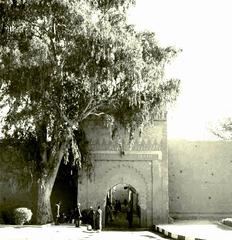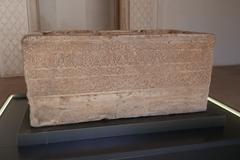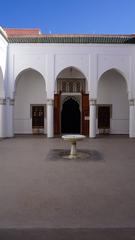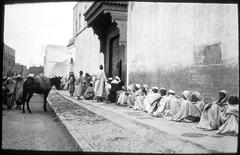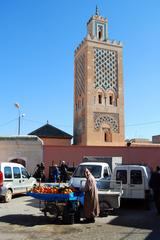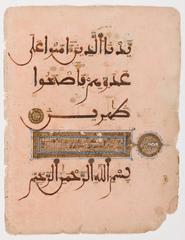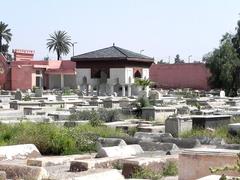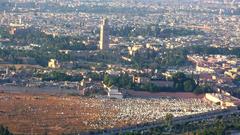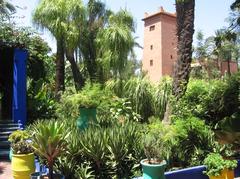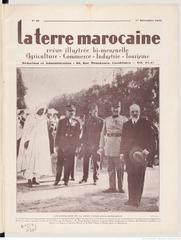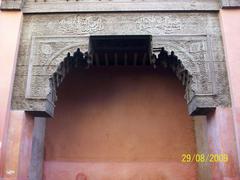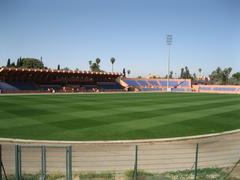Al-Qita Mosque and Koutoubia Mosque: Visiting Hours, Tickets, and Historical Significance in Marrakesh
Date: 15/06/2025
Introduction
Al-Qita Mosque, a lesser-known yet culturally significant landmark, lies within the bustling medina of Marrakesh. Often overshadowed by the nearby, world-renowned Koutoubia Mosque, Al-Qita embodies the enduring spiritual and architectural traditions that have shaped the city since its 11th-century foundation. This guide offers a detailed look at Al-Qita Mosque’s history, architecture, religious significance, visiting information, and its relationship to Marrakesh’s broader Islamic heritage.
For those interested in the city’s grandest religious monument, the Koutoubia Mosque — sometimes referred to as Al-Qita Mosque in local references — is also covered here, ensuring a complete understanding of Marrakesh’s sacred landscape. (Introducing Marrakech; See Morocco; UNESCO)
Contents
- Early Foundations and Historical Context
- Architectural Evolution and Features
- Religious and Cultural Significance
- Historical Preservation and Urban Role
- Visiting Al-Qita Mosque: Hours, Tickets & Visitor Tips
- The Koutoubia Mosque: History, Highlights, and Visitor Information
- Practical Visitor Advice
- Frequently Asked Questions (FAQs)
- Visual Highlights
- Conclusion & Recommendations
- Sources and Further Reading
Early Foundations and Historical Context
Al-Qita Mosque is deeply embedded in the historical heart of Marrakesh. The city was founded in 1062 CE by Yusuf ibn Tashfin of the Almoravid dynasty, who established Marrakesh as a fortified center for Islam, trade, and learning. The mosque’s name, “Al-Qita,” is rooted in the Arabic term for “section” or “district,” indicating its role as a local spiritual hub for its medina neighborhood. As the city expanded under successive dynasties, small mosques like Al-Qita were built to serve growing communities (Introducing Marrakech).
Architectural Evolution and Features
Al-Qita Mosque is a testament to the architectural layering that characterizes Marrakesh’s religious monuments. Drawing from the Almoravid and Almohad traditions, its design features horseshoe arches, a central sahn (courtyard), and a minaret that rises above the medina’s rooftops. The use of red sandstone and lime plaster ties the mosque to the city’s iconic “red” aesthetic.
Decorative details, such as geometric zellige tilework and carved wooden ceilings, showcase the skills of local artisans and echo the style seen in more prominent monuments like Koutoubia (Marrakech Like Locals; See Morocco).
Key Features:
- Mihrab: Indicates the direction of Mecca, adorned with subtle stucco or tilework.
- Minbar: Wooden pulpit with intricate geometric inlays.
- Minaret: A simple but elegant tower marking the mosque’s presence within the medina.
- Courtyard (Sahn): Provides space for ablutions and community gatherings.
Religious and Cultural Significance
Beyond its architectural value, Al-Qita Mosque is vital to communal life. It hosts the five daily prayers, Friday congregational prayer (Jumu’ah), and special services during major Islamic festivals such as Eid al-Fitr and Eid al-Adha (See Morocco). The mosque also functions as a center for religious education, mediation, and charity, reinforcing social bonds and passing on oral traditions through Quranic recitation.
The mosque’s minaret not only marks prayer times but serves as a spiritual beacon within the urban maze. Its integration with nearby madrasas and souks illustrates Marrakesh’s tradition of intertwining faith, education, and commerce (GPSmyCity).
Historical Preservation and Urban Role
Despite its modest scale, Al-Qita Mosque has endured through centuries of urban transformation and dynastic change. Marrakesh’s medina, a UNESCO World Heritage Site since 1985, has seen extensive preservation efforts aimed at safeguarding its historic religious sites (Morocco Photo Tours; UNESCO). Restoration initiatives focus on maintaining original materials and construction methods.
Al-Qita’s location within the medina places it at the heart of daily life, with the mosque’s rhythms influencing the operation of nearby markets and businesses. During Ramadan and other festivals, it becomes a focal point for communal gatherings and charity (Malika in Morocco; Bewildered in Morocco).
Visiting Al-Qita Mosque: Hours, Tickets & Visitor Tips
Visiting Hours & Access:
Al-Qita Mosque is primarily a functioning place of worship. Non-Muslim visitors are not permitted inside, in accordance with Moroccan law and tradition. However, the mosque’s exterior and minaret can be admired at any time from surrounding streets.
Tickets:
There is no entrance fee to view the mosque from outside.
Accessibility:
Located within the medina, the mosque is accessible by foot. The medina’s narrow, uneven streets may pose challenges for visitors with limited mobility.
Tips for Visitors:
- Dress modestly out of respect for local customs.
- Avoid visiting during prayer times to minimize disruption.
- Guided walking tours can provide historical context about the mosque and medina.
- Early morning or late afternoon visits offer a peaceful ambiance and favorable lighting.
Nearby Attractions:
Explore the Koutoubia Mosque, Ben Youssef Madrasa, and Marrakesh’s vibrant souks within walking distance.
Cultural Etiquette:
Always seek permission before photographing people or sensitive areas. During Ramadan, refrain from eating or drinking publicly during daylight hours (Morocco Wanderer).
The Koutoubia Mosque: History, Highlights, and Visitor Information
Historical and Architectural Overview
The Koutoubia Mosque, Marrakesh’s most iconic monument, was constructed in the mid-12th century under the Almohad dynasty. Its name, “Koutoubia,” means “booksellers’ mosque,” referencing the historic book market nearby.
Standing 77 meters tall, the minaret is a defining feature of the Marrakesh skyline, and its architectural style influenced landmarks across the Maghreb and Andalusia, including Seville’s Giralda and Rabat’s Hassan Tower (The Crazy Tourist).
Key Features
- Minaret: 77 meters tall, with a square base (12.8 meters per side), adorned with horseshoe arches, Kufic calligraphy, and turquoise-glazed tiles.
- Prayer Hall: Hypostyle design with 17 naves and over 100 columns.
- Courtyard: Tranquil setting with fountains and orange trees.
- Materials: Local sandstone, brick, stucco, and glazed tiles.
- Gardens: Well-maintained public gardens surround the mosque, offering shaded areas for relaxation.
Visiting Information
- Exterior and Gardens: Open daily from sunrise to sunset (Koutoubia Mosque Official). Non-Muslims are not permitted inside the prayer hall.
- Tickets: No entrance fee required.
- Dress Code: Modest attire is mandatory (StayHere.ma; Villas in Marrakech).
- Guided Tours: Available through local operators and often include historical context (Audiala).
- Accessibility: Gardens and paths are mostly accessible, but some areas may be uneven.
- Nearby Sites: Jemaa el-Fnaa, Saadian Tombs, Bahia Palace, and medina souks.
Special Considerations
During Ramadan and Islamic festivals, the mosque area becomes especially vibrant, with altered visiting patterns and large communal gatherings (Travel Plans Marrakech).
Practical Visitor Advice
- Arrive Early or Late: For fewer crowds and ideal lighting.
- Stay Hydrated: Especially important during hotter months.
- Respect Prayer Times: Avoid approaching entrances during calls to prayer.
- Photography: External photography is allowed; always ask before photographing people.
- Combine with Other Sites: Plan your visit to include nearby historical attractions for a comprehensive experience.
- Security: Be mindful of pickpockets in crowded areas (The Broke Backpacker).
- Guided Tours: Enhance your understanding with a local guide (Audiala).
Frequently Asked Questions (FAQs)
Q: Can non-Muslims enter Al-Qita or Koutoubia Mosque?
A: No, entry to the prayer halls is reserved for Muslims. Visitors can admire the exteriors and gardens.
Q: Are tickets required?
A: No, both mosques’ gardens and exteriors are freely accessible.
Q: What is the best time to visit?
A: Early mornings and late afternoons for comfortable weather and softer light.
Q: Are guided tours available?
A: Yes, many local tours include both mosques and provide historical context.
Q: Is there a dress code?
A: Yes, modest clothing is required at all times.
Visual Highlights
High-quality images and virtual tours greatly enhance the experience. Look for photos with descriptive alt text like “Al-Qita Mosque exterior in Marrakesh,” “Koutoubia Mosque minaret at sunset,” and “Moroccan zellige tilework at Al-Qita Mosque.”
Conclusion & Recommendations
Al-Qita Mosque, though less famous than Koutoubia, is a vital component of Marrakesh’s spiritual and architectural legacy, serving as a living link between the city’s past and present. The Koutoubia Mosque, with its monumental scale and global influence, stands as an enduring symbol of Marrakesh. Respect local customs, engage with knowledgeable guides, and explore the medina’s rich religious landscape for a truly immersive experience.
For up-to-date guides, virtual tours, and travel tips, download the Audiala app and follow us on social media. Delve deeper into Marrakesh’s heritage and enjoy an authentic journey through Morocco’s living history.
Sources and Further Reading
- Introducing Marrakech
- Marrakech Like Locals
- See Morocco
- Daily Sabah
- GPSmyCity
- Malika in Morocco
- Bewildered in Morocco
- UNESCO World Heritage Centre
- Morocco Photo Tours
- Morocco Wanderer
- Koutoubia Mosque Official
- The Crazy Tourist
- StayHere.ma
- Villas in Marrakech
- The Broke Backpacker
- Tourist Secrets
- Audiala
- Travel Plans Marrakech
